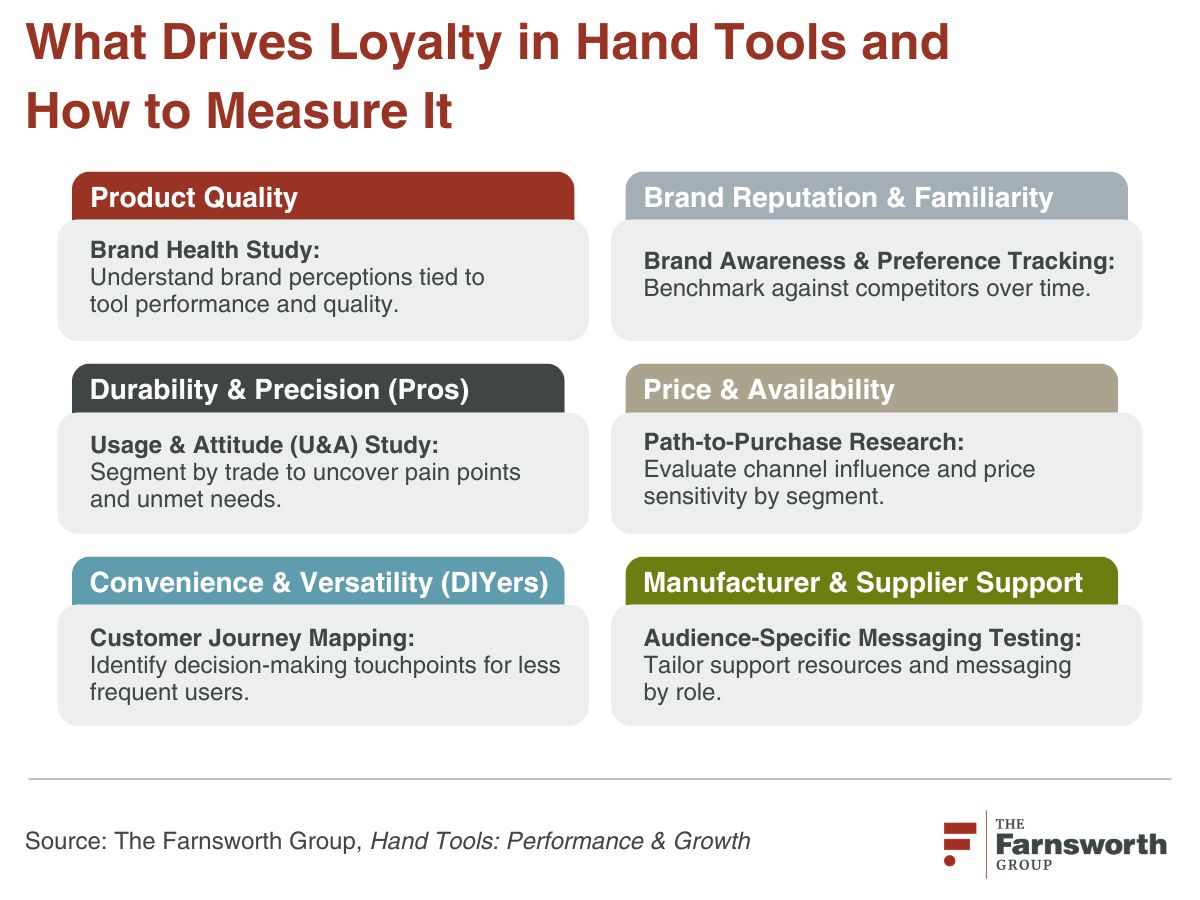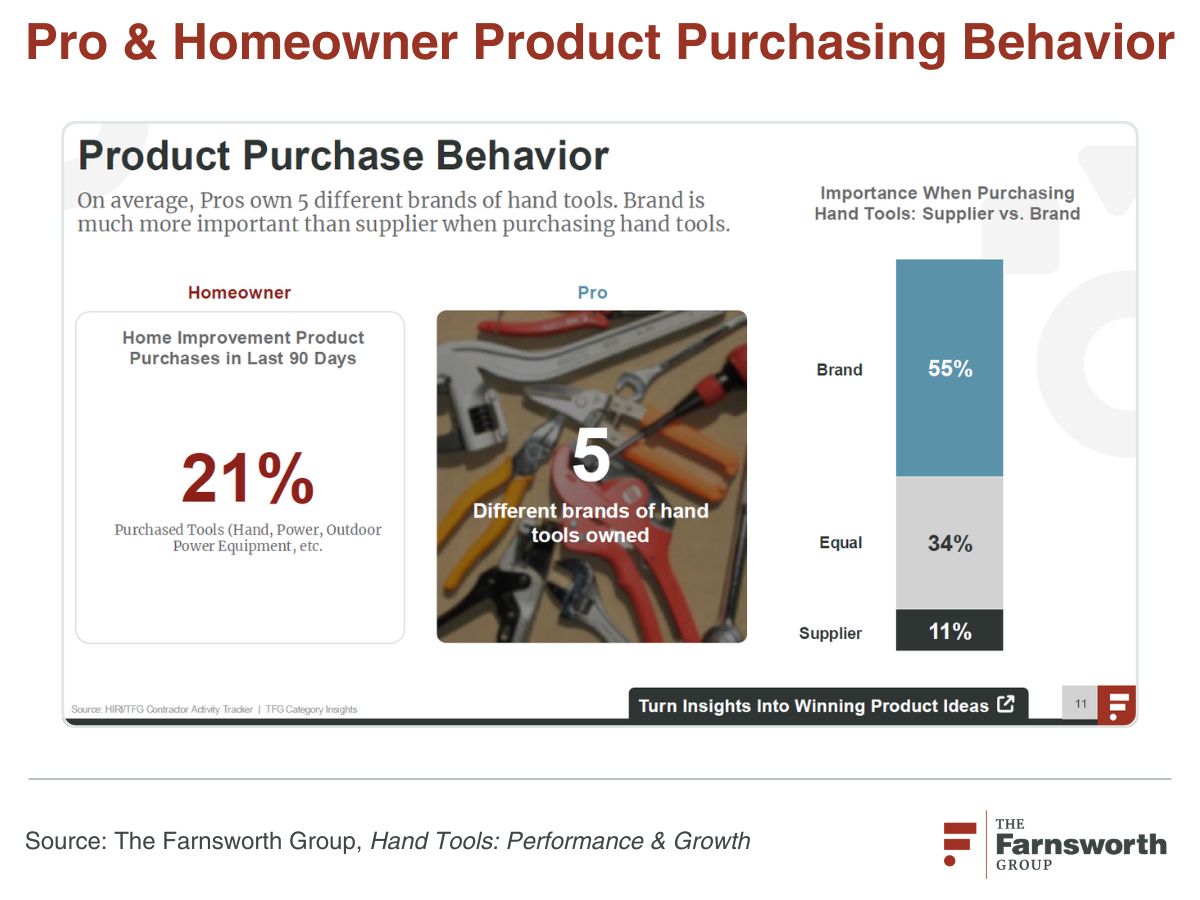Hand tools remain a foundational product category in building and home improvement with a high purchase incidence among both DIYers and Pros. Even with the rise of power tools and automation, both DIYers and trade professionals still rely on a wide range of hand tools including hammers, wrenches, pliers, and levels for everyday projects. This ongoing demand creates an opportunity for manufacturers to strengthen brand loyalty and market share when they successfully navigate the nuances of how customers think about hand tool options and suppliers when making purchasing decisions.
Market Outlook: Steady Growth Amid Shifting Dynamics
According to size of market forecasting from the Home Improvement Research Institute (HIRI), the year-over-year (YoY) growth from home improvement products is expected to improve in 2025 and continue growth in 2026.
Our Hand Tools: Performance and Growth research found that 1 in 5 homeowners had purchased some type of tool in the past 90 days. Some of the brands with the highest levels of awareness and use, according to our data, include DeWalt, Craftsman, STANLEY, Milwaukee, and Kobalt.
Within this dynamic and competitive market, hand tool brands have the opportunity to capture a greater share of the market. To do so requires a complete understanding of how DIYers and contractors interact with this product category.
- How are they using the tools and why?
- Where are they buying and why?
- What are they’re prioritizing when making their selections?
From convenience and accessibility, to price and durability, customers are weighing a number of factors in their decision-making process. Capturing incremental share requires understanding not just where people shop, but what drives their loyalty.

Loyalty is About More Than Quality
Quality remains table stakes for loyalty. DIYers consistently rank durability and ease-of-use as top priorities, while pros emphasize precision and reliability since tools are core to their livelihood and reputation on the job. Yet loyalty is rarely absolute: Based on our Hand Tools: Performance and Growth research findings, pros often own tools from five or more brands, demonstrating a willingness to mix and match based on task, price, or availability. Further, our research found that loyalty to hand tool brands outweighs loyalty to suppliers.

Manufacturers must go beyond “make it durable” to understand how trade-offs differ by segment. For instance:
- Pros are loyal to performance but open to switching if another brand offers superior reliability.
- DIYers value versatility and may be swayed by promotional pricing or retail availability.
Emerging Pressures on Hand Tools Manufacturers
Hand tools manufacturers face several unique challenges:
- Retail consolidation is giving distributors and big-box retailers more influence over which brands reach customers. This shift increases competition for shelf space and forces manufacturers to strengthen relationships with fewer, more powerful channel partners, and creating more competitive dynamics during product line reviews.
- Private label expansion continues to erode share from established players. As retailers push their own branded tools, national brands must work harder to demonstrate superior value and maintain direct B2C visibility outside of B2B channels.
- Technology and substitution are reshaping the category, as cordless power tools and automated solutions introduce new competitive threats and perhaps reduce demand for some traditional hand tools. Manufacturers must decide whether to double down on core categories or adapt product lines to complement and compete against these technologies.
- Sustainability expectations require companies to rethink materials, packaging, and end-of-life impact. Customers and specifiers alike are looking for eco-friendlier options, and brands risk being left behind if they don’t demonstrate progress.
- Counterfeit and low-cost tools are increasingly common in price-sensitive markets and unregulated channels. These knockoffs mimic branding but fail on quality and safety, eroding customer trust and damaging loyalty when failures are mistakenly linked to genuine brands.
These pressures heighten the importance of precise, segment-level insights. Brands that misread loyalty drivers risk losing share not only to direct competitors but also to retailers themselves.
Where Research Unlocks Better Decision Making
Off-the-shelf, secondary market data will only tell you part of the story. To strengthen loyalty, manufacturers need to uncover why customers choose one brand over another and how those choices shift across customer type. This requires digging into customer usage, attitudes, and behaviors.
Custom market research studies from The Farnsworth Group help you answer critical questions including:
- Who is purchasing which tools, how often, and where are they used?
- What product features or attributes drive brand preference and why?
- When are customers most likely to purchase a new tool or try or new brand?
- Where do different segments prefer to purchase (online or in-store) and why?
- Why does one brand deliver stronger repeat purchase rates than another?
These insights can reveal what matters most to customers and how translates into purchasing behavior. For example, our data often uncovers gaps between stated priorities (e.g., “quality is most important”) and derived priorities (e.g., customers choosing the lower-priced tools, even if not highest quality).
Turn Your Insights Into Action
Our clients leverage the research that we conduct to:
- Align product roadmaps with evolving customer needs, ensuring product features are prioritized correctly by segment.
- Refine channel strategies, balancing brand marketing with the channel influence of retailers and distributors on purchase incidence.
- Differentiate messaging, highlighting the right messaging for Pro and DIY audiences distinctly.
- Quantify loyalty drivers, identifying which levers, like quality, price, availability, function, actually shift purchase intent.
The clarity our research and recommendations provide gives leadership teams confidence in what to do next, like where to invest marketing dollars, which retail partnerships to strengthen, and which product innovations will deliver the greatest lift in loyalty and sales.
Expanding Your Reach With Custom Market Research
In a market where customers own tools from multiple brands and retailers wield outsized influence, loyalty isn’t guaranteed. But with the right data, it can be earned and sustained.
That's why, at The Farnsworth Group, we specialize in providing custom market research for building product manufacturers and suppliers. Our U&A studies go beyond surface-level trends to reveal the nuances of customer behavior and channel influence that are really driving purchase decisions.
Whether your goal is to increase share among pros, strengthen repeat purchases, or navigate shifting channel dynamics, we are here to help you by delivering actionable insights and recommendations that you can take to sharpen strategy and accelerate growth. To explore how market intelligence can inform your business strategy, schedule a consultation with our team.




